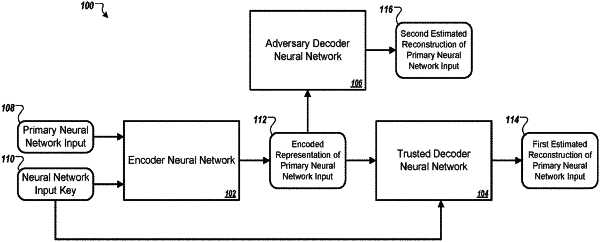| CPC G06N 3/045 (2023.01) [G06N 3/084 (2013.01)] | 15 Claims |

|
1. A computer-implemented method for training a neural network system on one or more computers, comprising:
obtaining a plurality of training data pairs for the neural network system, each training data pair comprising a respective first input and a respective second input; and
training the neural network system on the plurality of training data pairs, comprising, for each training data pair:
processing, using an encoder neural network in accordance with current values of parameters of the encoder neural network, (i) the respective first input for the training data pair and (ii) the respective second input for the training data pair to generate an encoded representation of the respective first input for the training data pair, wherein the respective second input for the training data pair represents a symmetric encryption key;
processing, using a first decoder neural network in accordance with current values of parameters of the first decoder neural network, (i) the encoded representation of the respective first input for the training data pair and (ii) the respective second input for the training data pair to generate a first estimated reconstruction of the respective first input for the training data pair;
obtaining a second estimated reconstruction of the respective first input for the training data pair, the second estimated reconstruction generated by a second decoder neural network in accordance with current parameters of the second decoder neural network, by processing the encoded representation of the respective first input for the training data pair without processing the respective second input for the training data pair; and
adjusting the current parameters of the encoder neural network and the current parameters of the first decoder neural network based on the respective first input, the first estimated reconstruction of the respective first input, and the second estimated reconstruction of the respective first input.
|